The Best Games for Sega’s Classic 16-Bit Console
Introduction
The Sega Mega Drive, also known as the Genesis in North America, holds a special place in the hearts of many gamers, and in this post I’m covering the best Megadrive games. Launched in 1988 in Japan and later in other regions, this 16-bit console was home to some of the best games ever made, defining a generation of gaming enthusiasts.
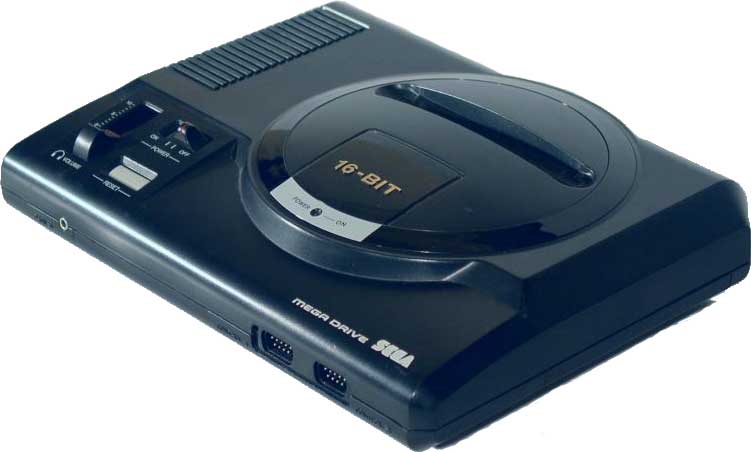
Its rich library of titles featured diverse genres, memorable characters, and innovative gameplay mechanics. This article explores the top 10 best Megadrive games, showcasing the titles that made gaming in the early 90s so memorable, and their lasting impact on the gaming industry.
10. Aero Blasters
One of the best Megadrive shooters
Aero Blasters (also known as Air Buster in some regions) is a standout title in the shoot ’em up genre. Developed by Kaneko and released in 1990, this game captured the hearts of Mega Drive fans with its exhilarating, fast-paced action and challenging levels.
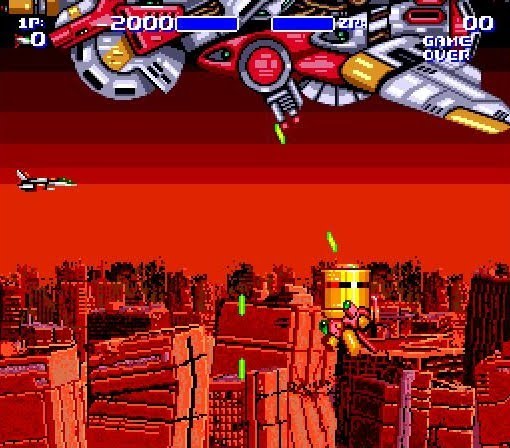
Gameplay
Aero Blasters puts players in the cockpit of a high-speed jet, navigating through enemy territories. The objective is to dodge enemy fire, navigate intricate levels, and destroy foes using a variety of powerful weapons. The game’s controls are fluid, allowing for precise movements and rapid shooting. Players face waves of enemies, mid-level mini-bosses, and end-level bosses, each requiring different strategies to defeat.
Graphics and Sound
For its time, Aero Blasters boasted impressive graphics with vibrant, detailed environments and well-designed enemy sprites. The game’s visual presentation was enhanced by smooth scrolling and dynamic effects, creating a sense of speed and urgency. The soundtrack complemented the high-energy gameplay, featuring catchy tunes and adrenaline-pumping beats that heightened the player’s experience.
Reception and Legacy
Aero Blasters received positive reviews for its engaging gameplay and technical achievements. As Mega Play magazine noted, “Aero Blasters is a frenetic shooter that keeps you on the edge of your seat with its relentless action and stunning visuals.” It remains a beloved title among shoot ’em up enthusiasts and has inspired many subsequent games in the genre. Its legacy endures as a testament to the innovative design and excitement of early 90s arcade-style gaming.
9. Golden Axe 2
The original side scrolling beat-em-up
Golden Axe 2 brought back beloved heroes for another round of hack-and-slash action. The game is renowned for its engaging combat and cooperative gameplay. Developed and published by Sega in 1991, this sequel continued the adventures in the mythical world of Yuria.
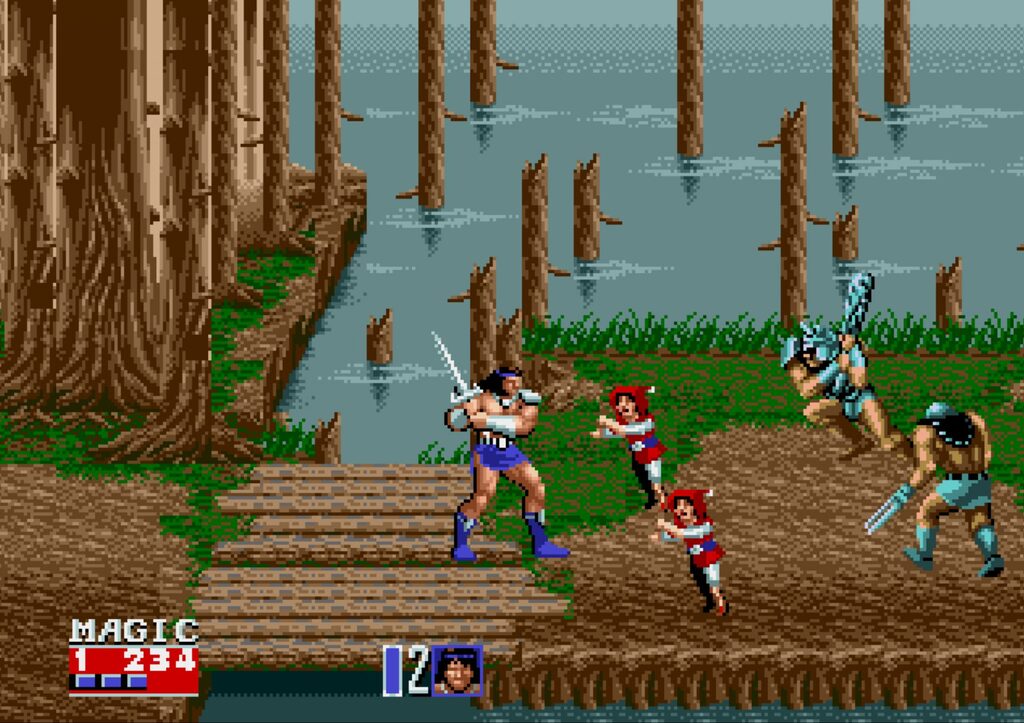
Gameplay
Players can choose from three characters: Ax Battler the Barbarian, Tyris Flare the Amazon, and Gilius Thunderhead the Dwarf. Each character has unique abilities and fighting styles, offering varied gameplay experiences. The game focuses on hand-to-hand combat, allowing players to perform a range of attacks, combos, and special moves. Magic spells, which differ for each character, add a strategic element to the gameplay.
Graphics and Sound
Golden Axe 2 improved upon its predecessor with more detailed graphics and smoother animations. The environments are richly designed, from dark forests to lava-filled caves, each adding to the game’s immersive atmosphere. The soundtrack features epic, heroic tunes that perfectly match the game’s fantasy setting and intense combat.
Reception and Legacy
The game was well-received for its refined mechanics and cooperative gameplay. MegaTech magazine praised it, stating, “Golden Axe 2 is a polished sequel that enhances everything we loved about the original.” Its impact on the beat ’em up genre is significant, influencing many subsequent games. Golden Axe 2 remains a staple of the MegaDrive library and a must-play for fans of the genre.
8. Strider
An amazing arcade conversion for the MegaDrive
Strider is an action-platformer developed by Capcom and released in 1990. It stands out for its fluid controls, acrobatic gameplay, and futuristic setting, making it one of the best MegaDrive games.

Gameplay
Players take on the role of Hiryu, a highly skilled ninja-like agent. The game features fast-paced platforming and combat, with Hiryu using his plasma sword, the Cypher, to defeat enemies. The gameplay emphasizes agility and precision, allowing Hiryu to perform acrobatic moves, scale walls, and execute devastating attacks. Each level is intricately designed, requiring players to navigate through traps, enemies, and challenging platforming sections.
Strider Graphics and Sound
Strider’s graphics were impressive for its time, featuring detailed sprites and smooth animations that brought the futuristic world to life. The environments are diverse, ranging from high-tech cities to desolate landscapes. The game’s soundtrack is equally memorable, with dynamic tracks that enhance the intense, action-packed gameplay.
Reception and Legacy
Strider was praised for its innovative gameplay and visual design. As described by Electronic Gaming Monthly, “Strider is a masterpiece of design and execution, combining thrilling action with a stunning visual style.” It became a classic title on the Mega Drive and has influenced many action-platformer games that followed. Its legacy endures, with Hiryu appearing in various Capcom games and the Strider franchise continuing to be celebrated by fans.
7. Revenge of Shinobi
Overview
Revenge of Shinobi, developed by Sega and released in 1989, is a challenging yet rewarding action game that has left a lasting impression on Mega Drive fans.

Megadrive Gameplay
Players control Joe Musashi, a ninja on a quest to rescue his kidnapped fiancée and defeat the Neo Zeed organization. The gameplay combines precision platforming with strategic combat. Joe can use shurikens, a katana, and powerful ninjutsu techniques to overcome enemies. Each level is designed with a variety of challenges, including tricky jumps, hidden traps, and formidable bosses.
Graphics and Sound
Revenge of Shinobi features detailed, colorful graphics that bring the game’s diverse environments to life. From urban landscapes to lush forests and ancient temples, each level is visually distinct. The game’s soundtrack, composed by Yuzo Koshiro, is legendary, with tracks that enhance the mood and intensity of the gameplay.
Reception and Legacy
The game was highly praised for its deep gameplay, challenging difficulty, and outstanding audio-visual presentation. MegaTech magazine lauded it, stating, “Revenge of Shinobi combines tight gameplay with an atmospheric score, creating a truly unforgettable experience.” Revenge of Shinobi is considered one of the best action games on the Mega Drive and has influenced many subsequent titles in the genre. Its legacy is a testament to the innovative design and enduring appeal of classic Sega games.
6. Rocket Knight Adventures
A truly original Megadrive game
Rocket Knight Adventures, developed by Konami and released in 1993, offered a unique twist to the platformer genre with its inventive gameplay and charming protagonist.
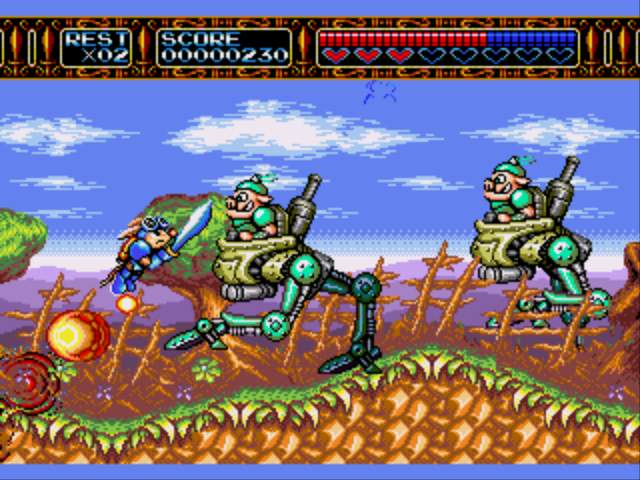
Gameplay
Players control Sparkster, an opossum knight equipped with a jetpack. The gameplay combines traditional platforming with unique mechanics, such as using the jetpack to fly and perform powerful rocket attacks. Levels are filled with enemies, obstacles, and puzzles that require both skill and strategy to overcome. The game’s controls are precise, allowing for smooth and responsive movements.
Graphics and Sound
Rocket Knight Adventures boasts vibrant, colorful graphics with detailed character sprites and richly designed environments. Each level is visually distinct, ranging from lush forests to mechanical fortresses. The game’s soundtrack is equally impressive, featuring catchy tunes that complement the adventurous spirit of the gameplay.
Reception and Legacy
The game received widespread acclaim for its innovative gameplay, charming design, and high production values. As noted by GameFan magazine, “Rocket Knight Adventures is a tour de force of platform gaming, showcasing Konami’s mastery in game design.” Rocket Knight Adventures remains a beloved title among platformer fans and is considered one of the best games on the Mega Drive. Its legacy continues to inspire developers and gamers alike.
5. Street Fighter 2
The MegaDrive’s best fighting game
Street Fighter 2, developed by Capcom and released on the Mega Drive in 1993, is an iconic fighting game that defined the genre and remains a staple for fans of competitive gaming.

Gameplay
Street Fighter 2 features a roster of memorable characters, each with unique fighting styles and special moves. Players can choose from a variety of fighters, including Ryu, Ken, Chun-Li, and Guile, and compete in one-on-one battles. The game’s mechanics are deep and strategic, with a focus on timing, combos, and counterattacks. Each match requires skill and precision, offering a rewarding experience for both casual and competitive players.
Graphics and Sound
The game’s graphics were exceptional for its time, with detailed character sprites and smooth animations that brought the fighters to life. The environments are equally impressive, with stages set in diverse locations around the world. The soundtrack features iconic themes for each character, enhancing the game’s atmosphere and intensity.
Reception and Legacy
Street Fighter 2 was a groundbreaking title that received critical acclaim and commercial success. Mean Machines Sega noted, “Street Fighter 2 is the pinnacle of fighting games, delivering unmatched depth and excitement.” It played a significant role in popularizing the fighting game genre and has influenced countless games since its release. The Mega Drive version remains a beloved classic, offering a timeless experience for fans of competitive fighting games.
4. Gunstar Heroes
The MegaDrive’s cult Run & Gun game
Gunstar Heroes, developed by Treasure and released in 1993, is celebrated for its chaotic, run-and-gun gameplay that provided endless entertainment.

Gameplay
Players navigate through intense levels, using a variety of weapons to defeat hordes of enemies. The game’s controls are fluid and responsive, allowing for precise shooting and acrobatic maneuvers. One of the standout features is the cooperative gameplay mode, which allows two players to tackle the game’s challenges together. The levels are diverse and creatively designed, with each one offering unique obstacles and enemies.
Graphics and Sound
Gunstar Heroes features vibrant, colorful graphics with detailed sprites and dynamic effects. The visual presentation is enhanced by smooth animations and explosive action, creating an immersive experience. The game’s soundtrack is equally engaging, featuring energetic tracks that complement the fast-paced gameplay.
Reception and Legacy
The game received widespread acclaim for its innovative design, cooperative gameplay, and high production values. GameFan magazine praised it, stating, “Gunstar Heroes is an explosive mix of creativity and pure fun, setting a new standard for action games.” Gunstar Heroes remains a beloved title among run-and-gun enthusiasts and is considered one of the best games on the Mega Drive. Its legacy continues to inspire developers and gamers, showcasing the timeless appeal of creative and dynamic gameplay.
3. Phantasy Star 4
The Best Megadrive RPG
Phantasy Star 4, developed by Sega and released in 1993, offered a deep and engaging experience for RPG enthusiasts. This epic space opera combined rich storytelling with engaging turn-based combat, making it a standout title on the Mega Drive.
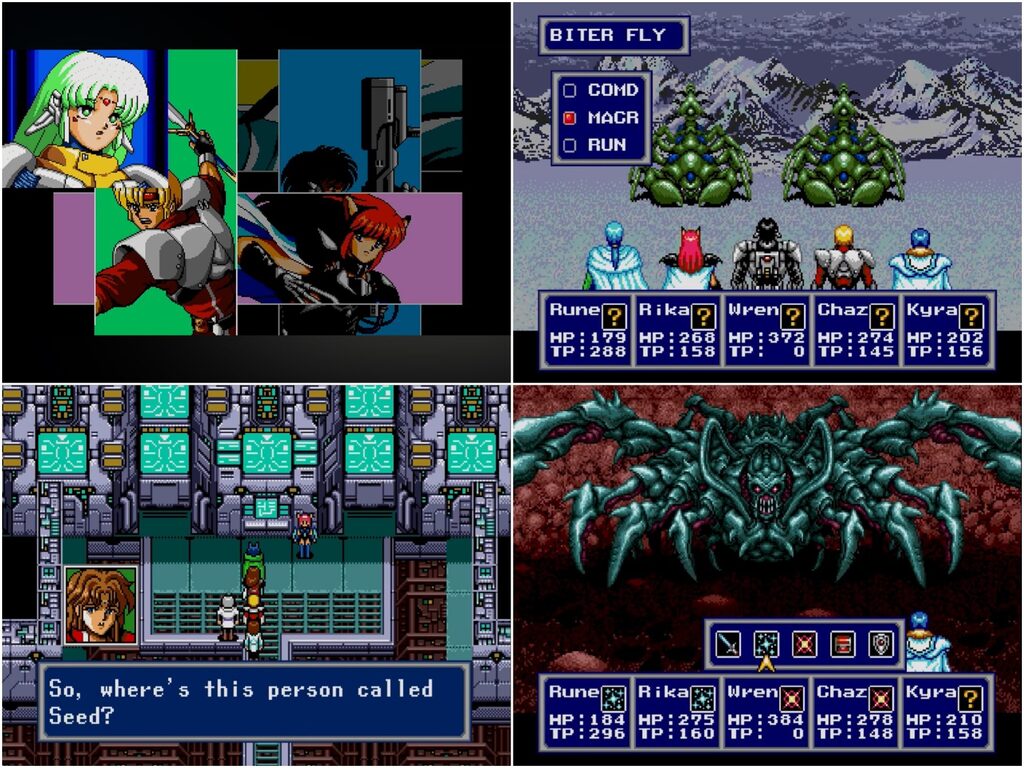
Gameplay
Phantasy Star 4 features a complex narrative set in the Algol Star System. Players control a party of characters, each with unique abilities and backgrounds, as they navigate through vast worlds and unravel the mysteries of the storyline. The gameplay focuses on turn-based combat, exploration, and character development. Players can engage in strategic battles, use powerful techniques, and customize their party’s abilities to overcome challenges.
Graphics and Sound
The game’s pixel art is beautifully detailed, bringing the diverse environments and characters to life. The visual design is complemented by dynamic animations and atmospheric effects. The soundtrack, composed by Izuho Numata and Masaki Nakagaki, features memorable tunes that enhance the emotional and epic moments of the game.
Reception and Legacy
Phantasy Star 4 received critical acclaim for its compelling narrative, deep gameplay mechanics, and high production values. Sega Pro magazine declared, “Phantasy Star 4 is a masterpiece of RPG design, offering a rich and immersive experience that stands the test of time.” It is considered one of the best RPGs on the Mega Drive and has influenced many subsequent titles in the genre. The game’s legacy endures, with fans continuing to celebrate its innovative design and storytelling.
2. Streets of Rage 2
The greatest scrolling beat-em up for the Megadrive
Streets of Rage 2, developed by Sega and released in 1992, elevated the beat ’em up genre with its refined gameplay and engaging soundtrack. It remains a classic title on the Mega Drive, known for its intense action and cooperative gameplay.

Gameplay
Players can choose from a variety of characters, each with unique move sets and fighting styles. The game focuses on hand-to-hand combat, allowing players to perform a range of attacks, combos, and special moves. The cooperative mode enhances the gameplay experience, allowing two players to team up and take down enemies together. The levels are creatively designed, offering a mix of street brawls, boss battles, and interactive environments.
Graphics and Sound
Streets of Rage 2 features smooth controls, detailed graphics, and fluid animations that bring the urban environments to life. The game’s visual design is complemented by a killer soundtrack composed by Yuzo Koshiro, featuring iconic tracks that still resonate with players today.
Reception and Legacy
The game was highly praised for its engaging gameplay, memorable music, and high production values. Mean Machines Sega magazine stated, “Streets of Rage 2 is the definitive beat ’em up, with unparalleled action and an unforgettable soundtrack.” Streets of Rage 2 is considered one of the best beat ’em up games ever made and has influenced many titles in the genre. Its legacy endures, with fans continuing to celebrate its innovative design and cooperative gameplay.
1. Sonic the Hedgehog 2
The best Megadrive game
Sonic the Hedgehog 2, developed by Sega and released in 1992, is perhaps the most iconic title on the Mega Drive. This game offers fast-paced gameplay, memorable levels, and introduced the beloved character Tails.

Gameplay
Players join Sonic and Tails on their quest to stop Dr. Robotnik from taking over the world. The game’s mechanics focus on speed and precision platforming, with players navigating through a variety of levels filled with enemies, obstacles, and secrets. The addition of the spin dash move added a new layer of speed and excitement, allowing players to blast through obstacles and enemies with ease.
Graphics and Sound
Sonic the Hedgehog 2 features vibrant, colorful graphics with detailed level design and smooth animations. The environments are diverse, ranging from the industrial Chemical Plant Zone to the neon-lit Casino Night Zone. The game’s soundtrack, composed by Masato Nakamura, is iconic, featuring memorable tracks that enhance the fast-paced gameplay.
Reception and Legacy
The game received critical acclaim for its innovative gameplay, high production values, and memorable design. Sega Pro magazine declared, “Sonic the Hedgehog 2 is the pinnacle of platform gaming, offering an exhilarating experience that remains unmatched.” Sonic the Hedgehog 2 played a significant role in solidifying Sonic as a flagship character for Sega and has influenced countless platformer games since its release. The game’s legacy endures, with fans continuing to celebrate its timeless appeal and exhilarating gameplay.
Revisiting the best ever Megadrive games
These ten games represent the best of the Sega Mega Drive, each contributing to the console’s enduring legacy. From fast-paced platformers and action-packed adventures to deep RPGs and intense beat ’em ups, these titles showcase the diversity and innovation that defined the 16-Bit era.




Awesome dude.
NIce, although I would counter ‘Strider’ with ‘Flashback’ for best looking platformer.
Fair point – I loved Flashback, the animation was great, reminding me of Prince of Persia from some angles. Strider only pips it for me as I was a fan of the arcade original.